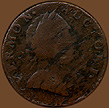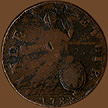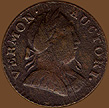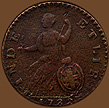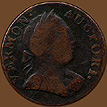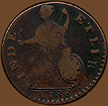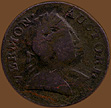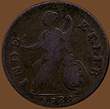Vermont Coppers, 1785-1788
Portrait varieties - 1788
obverse |
|
reverse |
| |||
1788 Bressett 13-L / RR 19 Bust right - VT Copper
Obverse: VERMON . AUCTORI .
Reverse: INDE ETLIB 1788
Weight: 118.9 g (7.70 grams) Diameter: 27.3 mm Reverse die alignment: 220°
Comments: The distinguishing feature of this bust right obverse
is that there is a die break around the rim starting at the R in VERMON
and continuing around to below the bust. Unfornunately on this example the
edges are worn but portions of the break can be detected especially above
the U abd C in AUCTORI.
The reverse of this coin constitutes the first use of die L. When obverse
die 13 failed reverse L was combined with obverse die 10. This reverse is
characterized by the single exergual line (between the figure and the date);
several varieties have two lines. Also note that the first stroke of the
N in INDE lacks a bottom serif. This example is fairly worn and includes
some planchet voids. The following well preserved example also uses this
reverse.
Provenance: From the Robert H. Gore, Jr. Numismatic Collection.
obverse |
|
reverse |
| |||
1788 Bressett 10-L / RR 20 Bust right - VT Copper
Obverse: VERMON . AUCTORI .
Reverse: INDE ETLIB 1788
Weight: 110.8 g (7.18 grams) Diameter: 27.2 mm Reverse die alignment: 180°
Comments: Obverse die 10 was the first of the bust right obverse
dies. It was cut by James Atlee sometime after July of 1787 and continued
in use on coins dated through the following year of 1788. Over that period
it was combined with several reverses. Bressett lists the sequence in the
following order: first it was combined with the J reverse, then the K, L,
M, N, O, P, Q and R reverses. The present coin represents the third combination
in the life of this obverse die. Die 10 can be distinguished in that the
final stroke of the N touches the head of the bust and the V points to a
space between the ribbon ends (called fillets). There is also a small die
crack at the bridge of the nose appearing in this example as a dot. This
example has a planchet void below the chin.
This reverse is the second use of the L reverse die. See the description
of 13-L, which was the first use of the L reverse, for basic die characteristics. During this period the top quarter of the die buckled,
so that it bulged out slightly from the E in INDE across to about the ET.
Thus the top section of the coin is not flat with the remaining surface but
is slightly depressed or indented. There is also a die crack from the portion of the right arm near the body extending through the branch and into the letter E in INDE. In this example the surface is rather porous and the thin crack is barely visible.
Provenance: From the Robert H. Gore, Jr. Numismatic Collection.
obverse |
|
reverse |
| |||
1788 Bressett 10-O / RR 23 Bust right - VT Copper
Obverse: VERMON . AUCTORI .
Reverse: INDE ETLIB 1788
Weight: 108.6 g (7.04 grams) Diameter: 26.9 mm Reverse die alignment: 150°
Comments: Obverse die 10 was the first of the bust right obverse dies. It was cut by James Atlee sometime after July of 1787 and continued in use on coins dated through the following year of 1788. Over that period it was combined with several reverses. Bressett lists the sequence in the following order: first it was combined with the J reverse, then the K, L, M, N, O, P, Q and R reverses. The present coin represents the sixth combination in the life of this obverse die. Die 10 can be distinguished in that the final stroke of the N touches the head of the bust and the V points to a space between the ribbon ends (called fillets). There is also a small die crack at the bridge of the nose appearing in this example as a dot. The dot of metal above the stop following VERMON is due to a planchet problem rather than the die.
Mailed bust right; Reverse die O can be distinugished by the double exergual line that is not parallel but comes closer together on the right side. It is also the only die where the final 8 goes above the bottom exergual line. This example is from an earlier use of the die, for late in its use a die crack developed from the pole to the rim (see the next example).
Provenance: From the Robert H. Gore, Jr. Numismatic Collection.
obverse |
|
reverse |
| |||
1788 Bressett 10-O / RR 23 Bust right- VT Copper
Obverse: VERMON . AUCTORI .
Reverse: INDE ETLIB 1788
Weight: 110.7 g (7.17 grams) Diameter: 27.7 mm Reverse die alignment: 190°
Comments: See the previous example for a discussion of the obverse and reverse dies. There are planchet voids and fissure cracks on the obverse. The reverse is a later state of the die than the previous example. Note the die crack from the center of the pole (between the hand and the shoulder) extending up to the rim.
Provenance: From the Robert H. Gore, Jr. Numismatic Collection.
| Vermont Coppers: p. 1 | Section Contents | Vermont Coppers: p. 3 |
|
For viewing tips and information on optimal computer settings click
here.
For questions or comments contact Special Collections by: |
